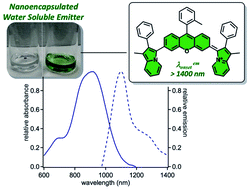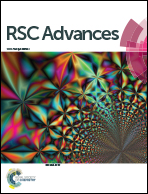SWIR emissive RosIndolizine dyes with nanoencapsulation in water soluble dendrimers†
Abstract
Shortwave infrared (SWIR) emission has great potential for deep-tissue in vivo biological imaging with high resolution. In this article, the synthesis and characterization of two new xanthene-based RosIndolizine dyes coded PhRosIndz and tolRosIndz is presented. The dyes are characterized via femtosecond transient absorption spectroscopy as well as steady-state absorption and emission spectroscopies. The emission of these dyes is shown in the SWIR region with peak emission at 1097 nm. TolRosIndz was encapsulated with an amphiphilic linear dendritic block co-polymer (LDBC) coded 10-PhPCL-G3 with high uptake yield. Further, cellular toxicity was examined in vitro using HEK (human embryonic kidney) cells where a >90% cell viability was observed at practical concentrations of the encapsulated dye which indicates low toxicity and reasonable biocompatibility.



 Please wait while we load your content...
Please wait while we load your content...